CCNA – RIP Questions
Here you will find answers to RIP Questions
Note: If you are not sure about RIP, please read my RIP tutorial.
Question 1
Which statement about RIPng is true?
A. RIPng allows for routes with up to 30 hops.
B. RIPng is enabled on each interface separately.
C. RIPng uses broadcasts to exchange routes.
D. There can be only one RIPng process per router.
Answer: B
Explanation
RIPng is similar to RIPv2 but is used for IPv6. But unlike RIPv1 and RIPv2, RIPng is enabled on each interface separately. For example:
Router(config)#ipv6 unicast-routing (Enables the forwarding of IPv6 unicast datagrams globally on the router)
Router(config)#interface fa0/0
Router(config-if)#ipv6 rip 9tut enable (9tut is the process name of this RIPng)
Question 2
What are two characteristics of RIPv2? (Choose two)
A. classful routing protocol
B. variable-length subnet masks
C. broadcast addressing
D. manual route summarization
E. uses SPF algorithm to compute path
Answer: B D
Question 3
Refer to the exhibit. Which (config-router) command will allow the network represented on the interface to be advertised by RIP?
| router rip version 2 no auto summary ! interface ethernet0 ip address 10.12.6.1 255.255.0.0 |
A. redistribute ethernet0
B. network ethernet0
C. redistribute 10.12.0.0
D. network 10.12.0.0
Answer: D
Question 4
Refer to the exhibit. What information can be gathered from the output?
| RouterA#debug ip rip RIP protocol debugging is on00:34:32: RIP: sending v2 flash update to 224.0.0.9 via FastEthernet8/0 (172.16.1.1) 00:34:32: RIP: build flash update entries 00:34:32: 10.10.1.0/24 via 0.0.0.6, metric 1, tag 0 00:34:32: RIP: sending v2 flash update to 224.0.0.9 via Loopback (10.10.1.1) 00:34:32: RIP: build flash update entries 00:34:32: 10.0.0.0/8 via 0.6.0.0, metric 2, tag 0 00:34:32: 172.16.1.0/24 via 0.0.0.0, metric 1, tag 0 00:34:32: RIP: ignored v2 packet from 16.10.1.1 (sourced from one of our addresses) 06:34:33: RIP: received v2 update from 172.16.1.2 on FastEthernet0/6 66:34:33: 16.6.0.0/8 via 6.0.6.6 in 1 hops 66:34:44: RIP: sending v2 update to 224.6.6.9 via FastEthernet0/0 (172.16.1.1) 66:34:44: RIP: build update entries 66:34:44: 10.10.1.0/24 via 0.0.0.0, metric 1, tag 0 |
A. One router is running RIPv1.
B. RIP neighbor is 224.0.0.9.
C. The network contains a loop.
D. Network 10.10.1.0 is reachable.
Answer: D
Question 5
Which series of commands will configure router R1 for LAN-to-LAN communication with router R2? The enterprise network address is 192.1.1.0/24 and the routing protocol in use is RIP. (Choose three)
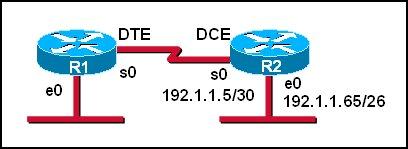
A.
R1 (config)# interface ethernet 0
R1 (config-if)# ip address 192.1.1.129 255.255.255.192
R1 (config-if)# no shutdown
B.
R1 (config)# interface ethernet 0
R1(config-if)#ip address 192.1.1.97 255.255.255.192
R1 (config-if)# no shutdown
C.
R1 (config)# interface serial 0
R1 (config-if)# ip address 192.1.1.4 255.255.255.252
R1 (config-if)# clock rate 56000
D.
R1 (config)# interface serial 0
R1(config-if)#ip address 192.1.1.6 255.255.255.252
R1 (config-it)# no shutdown
E.
R1 (config)# router rip
R1 (config-router)# network 192.1.1.4
R1 (config-router)# network 192.1.1.128
F.
R1 (config)# router rip
R1 (config-router)# version 2
R1 (config-router)# network 192.1.1.0
Answer: A D F
Explanation
First we notice that the ip address of the E0 interface of R2 is 192.1.1.65/26, which has:
+ Increment: 64 (/26 = 1111 1111.1111 1111.1111 1111.1100 0000)
+ Network address: 192.1.1.64
+ Broadcast address: 192.1.1.127
Therefore, the ip address of the E0 interface of R1 cannot belong to this range or the network cannot operate correctly.
In answer A, the ip address of E0 interface of R1 is 192.1.1.129, which does not belong in this range -> A is correct.
In answer B, E0 interface of R1 has the ip address of 192.1.1.97, which belongs in this range -> B is not correct.
The s0 interface of R1 must belong to the same network of s0 interface of R2, which has:
+ Increment: 4 (/30 = 1111 1111.1111 1111.1111 1111.1111 1100)
+ Network address: 192.1.1.4
+ Broadcast address: 192.1.1.7
The ip 192.1.1.5 has been used by s0 of R2 so the only suitable ip address of s0 of R1 is 192.1.1.6 -> C is wrong but D is correct.
Now the last thing we must do is enabling RIP. Because e0 interface of R1 and e0 interface of R2 have the same major network (192.1.1.0/24) so we must use RIP version 2 to support discontiguous network -> F is correct.
For answer E, if we configure 2 networks
R1 (config-router)# network 192.1.1.4
R1 (config-router)# network 192.1.1.128
then these networks will be automatically summarized as 192.1.1.0 network.
Question 6
Refer to the exhibit. Two routers have just been configured by a new technician. All interfaces are up. However, the routers are not sharing their routing tables. What is the problem?

A. Split horizon is preventing Router2 from receiving routing information from Router1.
B. Router1 is configured for RIP version 2, and Router2 is configured for RIP version 1.
C. Router1 has an ACL that is blocking RIP version 2.
D. There is a physical connectivity problem between Router1 and Router2.
E. Router1 is using authentication and Router2 is not.
Answer: B
Explanation
As we can see from the output, Router2 is sending v1 update and ignoring v2 update from neighbor so we can conclude Router2 is running RIPv1. Its neighbor, Router1 (ip address of 192.168.2.1), is running RIPv2.
Notice that router running RIPv2 can “understand” RIPv1 update but router running RIPv1 cannot understand RIPv2 update.
Question 7
What is the default routing update period for RIPv2?
A. 15 seconds
B. 30 Seconds
C. 180 Seconds
D. 240 Seconds
Answer: B
Question 8
Refer to the exhibit. The network manager is evaluating the efficiency of the current network design. RIPv2 is enabled on all Layer 3 devices in the network. What network devices participate in passing traffic from the PC at 10.10.1.7 to File Server at 10.20.1.6 in the order that they will forward traffic from source to destination?
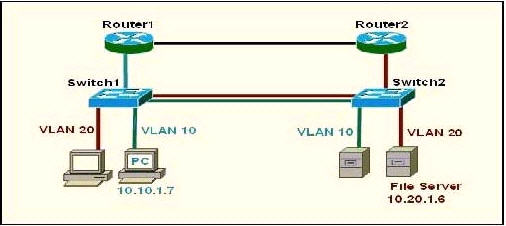
A. Switch, Switch2
B. Switch, Switch2, Router2, Switch2
C. Switch1, Router1, Switch1, Switch2
D. Switch1, Router1, Router2, Switch2
Answer: D
Explanation
The PC and File Server are in different VLANs so surely traffic from PC to File Server must go through Router1 but which path will the packet go next, through Router 2 or Switch1? Well, it is a hard question to answer.
As many comments said “the connection between R1 and Switch is Blue, so that means its under Vlan 10, and R2 to Switch 2 is red. The two routers do not have subinterfaces and are not running router on a stick basing on the color of the links” so D should be the correct answer.
Just for your information, I keep this explanation (which supports answer C) but in the exam you should choose D as your answer!
I haven’t had tested it yet but I guess that because there is a VLAN 20 on Switch 1 so Router1 will try to send that packet back to Switch1. If the link between Switch1 and Switch2 is a trunk link then the returned packet will also be sent to this link. Switch 2 receives that packet and it sends to the File Server at VLAN20. So the path will be Switch1 -> Router1 -> Switch1 -> Switch2.
There are some debates about this question but if the routers are properly configured then the packets can go from Switch1 -> Router1 -> Router2 -> Switch2 (D answer) so D can be a correct answer.
Question 9
Refer to the exhibit. Router A has interfaces with addresses 192.168.1.1 and 172.16.1.1. Router B, which is connected to router A over a serial link, has interfaces with address 172.16.1.2 and 10.1.1.2.
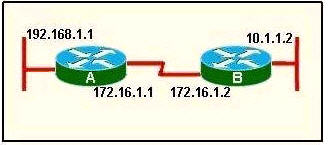
Which sequence of commands will configure RIPv2 on router B?
A.
B( config)# router rip
B(config-router)#version 2
B(config-router)# network 172.16.0.0
B(config-router)# network 10.0.0.0
B(config-router)# end
B.
B(config)# router rip 2
B(config-router)# network 172.16.0.0
B(config-router)# network 10.0.0.0
B(config-router)# end
C.
B(config)# router rip
B(config-router)#version 2
B(config-router)# network 172.16.0.0
B(config-router)#network 192.168.1.0
B(config-router)#end
D.
B(config)# router rip version 2
B(config-router)# network 172.16.0.0
B(config-router)# network 10.0.0.0
B(config-router)#end
Answer: A
Question 10
Refer to the exhibit. S0/0 on R1 is configured as a multipoint interface to communicate with R2 and R3 in this hub-and-spoke Frame Relay topology.
While testing this configuration, a technician notes that pings are successful from hosts on the 172.16.1.0/24 network to hosts on both the 172.16.2.0/25 and 172.16.2.128/25 networks. However, pings between hosts on the 172.16.2.0/25 and 172.16.2.128/25 networks are not successful. What could explain this connectivity problem?
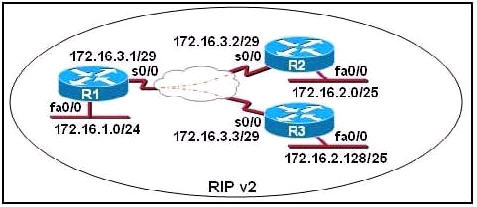
A. The ip subnet-zero command has been issued on the R1 router.
B. The RIP v2 dynamic routing protocol cannot be used across a Frame Relay network.
C. Split horizon is preventing R2 from learning about the R3 networks and R3 from learning about the R2 networks.
D. The 172.16.2.0/25 and 172.16.2.128/25 networks are overlapping networks that can be seen by R1, but not between R2 and R3.
E. The 172.16.3.0/29 network used on the Frame Relay links is creating a discontiguous network between the R2 and R3 router subnetworks.
Answer: C
Explanation
The “ip subnet-zero” allows the use of the first subnet but it doesn’t cause this problem and we don’t have that first subnet (like 172.16.0.0/24) so we can’t confirm if the “ip subnet-zero” was used or not -> A is not correct.
Frame-Relay can use RIPv2 with no problem if we configure it correctly -> B is not correct.
In the exhibit above we notice that the s0/0 interface of R1 has not been divided into sub-interfaces so the split horizon will prevent updates from R2 to R3 and vice versa. The split horizon rule states “A router never sends information about a route back in same direction which is original information came”. In this case R2 send an update to S0/0 of R1 so R1 cannot send that update back on S0/0 -> R3 will not learn about networks of R2 (and vice versa) -> C is correct.
172.16.2.0/25 and 172.16.2.128/25 networks are not overlapping networks. They are two different sub-networks -> D is not correct.
RIPv2 is a classless routing protocol so it supports VLSM and discontiguous networks -> E is not correct.
Question 11
Refer to the exhibit. After a RIP route is marked invalid on Router_1, how much time will elapse before that route is removed from the routing table?
| Router_1# show ip protocols Routing Protocol is “rip” Sending updates every 30 seconds, next due in 8 seconds Invalid after 180 seconds, hold down 180, flushed after 240 Outgoing update filter list foe all interfaces is not set Incoming update filter list for all interfaces is not set Router 1# |
A. 30 seconds
B. 60 seconds
C. 90 seconds
D. 180 seconds
E. 240 seconds
Answer: B
Explanation
The question reads: After a RIP route marked invalid on Router_1, how much time will elasped before that route is removed from the routing table.
The word “REMOVED” in the question means “FLUSHED”
Carefully look at the Router_1 show ip protocol output:
Invalid is 180 secs.
Flushed is 240secs.
RIP route marked invalid (180secs.)
Time elasped before route is removed (Flushed 240secs.)
The difference is 60secs……..240-180=60. Actually is 180+60=240.
Please notice that the invalid timer, hold down timer and flush timer start counting at the same time.
Question 12
Refer to the graphic. Host 1 cannot receive packets from Host 2. Assuming that RIP v1 is the routing protocol in use, what is wrong with the IP configuration information shown? (Choose two)
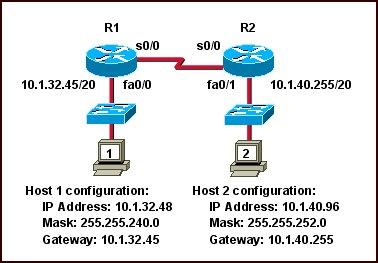
A. The fa0/1 interface of router R2 has been assigned a broadcast address.
B. The fa0/1 network on router R2 overlaps with the LAN attached to R1.
C. Host 2 has been assigned the incorrect subnet mask.
D. Host 1 has been configured with the 255.255.248.0 subnet mask.
E. Host 2 on router R2 is on a different subnet than its gateway.
Answer: B C
Explanation
The fa0/1 interface of R2 is assigned an IP address of 10.1.40.255/20. It seems to be a broadcast address but it is not. If we calculate the range of this network we will understand why:
Network 10.1.40.255/20
Increment: 16 (/20 = 1111 1111.1111 1111.1111 0000.0000 0000)
Network address: 10.1.32.0
Broadcast address: 10.1.47.255
-> 10.1.40.255/20 is an usable host address -> A is not correct.
The IP address of host 1 (10.1.32.48) belongs to the range of interface fa0/1 on R2 as shown above -> B is correct.
In the topology above, all subnet masks are /20 (255.255.240.0) excepting the subnet mask of Host 2 (255.255.252.0) so C can be incorrect.
The subnet mask of Host 1 is 255.255.240.0, not 255.255.248.0 -> D is not correct.
Host 2 is not on a different subnet than its gateway even if the subnet mask 255.255.252.0 is used. Let’s analyze the range of Host 2 network:
Network 10.1.40.96/22
Increment: 4
Network address: 10.1.40.0
Broadcast address: 10.1.43.255
Its gateway (10.1.40.255) is still belongs to this range -> E is not correct.
Note: In this question, C is the best suitable answer after eliminating A, D, E answers. But in fact Host 2 can ping its gateway because they are on the same subnet.
Question 13
What two things will a router do when running a distance vector routing protocol? (Choose two)
A. Send periodic updates regardless of topology changes.
B. Send entire routing table to all routers in the routing domain.
C. Use the shortest-path algorithm to the determine best path.
D. Update the routing table based on updates from their neighbors.
E. Maintain the topology of the entire network in its database.
Answer: A D
Question 14
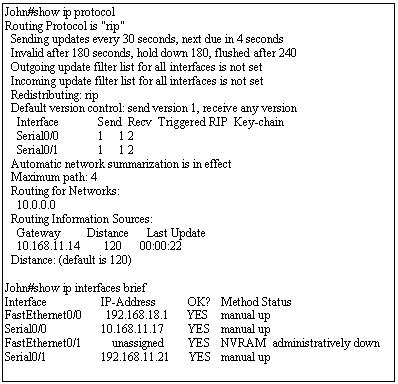
Use the output from the router shown in the graphic above to determine which of the following are correct. (Choose two)
A. Router John uses a link-state routing protocol.
B. Router John will receive routing updates on the Serial0/0 interface.
C. Router John will receive routing updates on the Serial0/1 interface.
D. Router John will send routing updates out the Serial0/0 interface.
E. Router John will send routing updates out the FastEthernet0/0 interface.
F. Router John will send routing updates out the Serial0/1 interface.
Answer: B D
Explanation
As you can see under “Routing for networks”, network “10.0.0.0″ is advertising. The IP address of S0/0 is 10.168.11.17 which belongs to 10.0.0.0 network -> RIP is running on s0/0 interface only, not s0/1 -> S0/0 will send and receive RIP updates.
Question 15
What can be determined from the line of show ip route output shown in the exhibit? (Choose two)
R 10.10.10.8 [120/2] via 10.10.10.6,00:00:25, Serial0/1
A. The next routing update can be expected in 35 seconds.
B. The IP address 10.10.10.6 is configured on S0/1.
C. The IP address 10.10.10.8 is configured on S0/1.
D. This route is using the default administrative distance.
E. The 10.10.10.8 network is two hops away from this router.
Answer: D E
Explanation
From the output, we can see 2 parameters [120/2]. The first is the administrative distance of the routing protocol being used. In this case it is RIP (symbolized by the letter “R”). Because 120 is also the default administrative distance value of RIP -> D is correct.
In RIP, the metric is hop count so “2″ means the network 10.10.10.8 is two hops (routers) away from this router.



Hi. I’m going to pass the CCNA exam in May. If you have the latest dumps of CCNA, I’ll be very grateful if you could sendthem to me. Many thanks. andrew_ccna@yahoo.com
writing my ccna june please latest dumps to africanjumbo@gmail.com.
Why are we still debating Q11? To get the answer, please count the time AFTER the route is marked invalid. That’s 60 seconds later.
Yes, it does take a total of 240 seconds for this to happen, but we need to check the time after the route became invalid (in this question). That’s 60 s later.
Hope this helps!
If some network goes down, does router start INVALID timer, and after that 180 seconds sends update with metric 15 to that network? In which situation router wait for invalid timer to declare route to network? If I understood well, if network goes down, router send immediately triggered update to inform others… So I’m confused, in which situation will it wait for invalid timer?
After hearing a poisoned rute, does during hold down timer, router sending routes with metric 16 (for some network), or router waits for hold down timer to expire and until than sending metric which has been already in routing table (which is less than 16)?
Q14
For those that assume the DG is 192.10.11.14, it’s NOT, it is 10.168.10.14
I was so perplexed with this question until I realized it was a Class-A and Not a Class-C address.
whoops, I meant 192.168.11.14 and the correct is a Class-A 10.168.11.14
@9tut
@xallax
@steph
As STEPH said:
If a router does not receive an update for a RIP route after 180 sec (default invalid timer), the route enters the hold-down timer and is mark as possibly-down (180 sec default), the flush timer also begins (240 secs default). After the hold-down timer’s period ends, there is another 60 sec (flush timer) before the route is completely removed from the routing table.
I tried is on simulation, and it really turns that after route is marked invalid, it still needs 180+60=240sec to delete it from routing table!?
Please comment!
IS there anyone who got 100% at exam, which could tell as Cisco’s answer on this Q11. please?
Obviously, there are different approaches on fact – when each timer starts… I also tried with Packet tracer, and after route is marked invalid, it really needed 240sec to delete route from table. Timers are default. I think that 60sec is not correct answer!
@bryan
yes, it take 240 sec per total BUT it is asking how long after it was marked invalid. get it? :)
I mean, 240 sec AFTER route is marked invalid. I tried it today in Packet tracer.
Cisco says for flush timer: “If the interval is less than the sum of the update and holddown values, the proper holddown interval cannot elapse, which results in a new route being accepted before the holddown interval expires.”
It means, when hold down timer starts, after invalid timer expired, that holddown timer will only count 60sec, not 180, and it will never elapse. In our case, route will be deleted before it should be.
Is packet tracer wrong?
What is
hi i think the answer to Q11 ….how much time will elapse before that route is removed from the routing table? is 240 seconds flushed from the routing table
Can someone please explain this, as I cannot find an explanation anywhere on the Internet.
Question 4: What is it in the Debug IP Rip statement that indicates networ 10.10.0.1 is unreachable? I am trying to find something of common sense that would lead one to this conclusion.
Thanks.
Hi guys.
You can advise the below question ?
The answer is A.
In the communication between A et B wich technology or witch protocol is represented bs dashed line A?
A. IP
B.T1
C.PPP
D.IEEE 802.3
Asnwer is A. why ?
PC1 ———–A————PC2
| |
| |
SW1————B———–SW2
| |
| |
R1—————C————R2
| |
| |
CSU/DSU——-D——-CSU/DSU
@Anonymous.. I think the right answer is D. Switches (within the context of L2 switches) uses data-link header information (i.e. MAC add) to forward frames.
@Anonymous… Ow! sorry I misinterpreted your question. The right answer is A. IP’s purpose is to provide end-to-end delivery of packets from PC1 to PC2.
T1 is a layer1 technology used between CSU/DSUs.
PPP layer2 between R1 and R2.
IEEE 802.3 layer 2 between SW1 and R1, SW2 and R2, SW1 and PC1, SW2 and PC2.
About question 13 this is my point of view:
RIP and EIGRP are considered distance vector routing protocol.
RIP sends periodic update but EIGRP doesn’t sends periodic updates, EIGRP sends updates when there is any change of topology. So answer A is no correct.
RIP sends the entire routing table just for their neighbors, in the other hand EIGRP sends partial updates, no entire routing table, for their neighbors. So answer B is not correct.
The only one correct answer I can see is D.
If anyone have another point of view, explanation or have another question, pls write me at visitantejc666@gmail.com
Q1 and Q8 were in my exam today…
I want to be to do the examination for CISCO next time so i want to understand well for many configuring some education on it for foundation can you explain and advice for me first ??
Hi all, I am taking CCNA 640-802 exam first time on 30/05/2012. Could anyone please send me latest dumps which are valid for UK? My e-mail address is puneet_gill84@yahoo.co.uk. Many thanks.
RE: q4 — debug ip rip output — what do I look for when I first see this?
This is such a lot of info and we need to be fast to pass the test
can you send me the latest dump i will taking exam soon in june 2012 please send it to dexdomingo@yahoo.com thanks
CCNA exam i mean can you send me the latest dump thru my email thanks
to Q11? to whomsoever….
my explanation is it is asked how how much time will elapse before that route is removed from the routing table…
n it is stated tat it is already been marked invalid… ie already 180 sec is passed…..
now as per question hw much time to remove so the flush time is 240 sec….
hence the time elapsed is from 180 to 240 ie 60 sec wch is the answer…..
i hope this will help in clearing the doubts……
About Question 1.
In CCNA course-ware RIPng which is for IPv6 is not covered, is it? If it isn’t then why there are questions about RIPng?
Q11 I how much time will elapse before that route is removed from the routing table?
I know the flush time is 240 secs and the Invalid time is 180 secs (240-180=60), but I have gone through few dumps and forums who say its 240 secs. Can you please explain?
I PASSED CCNA EXAM TODAY THANKS TO ALL MIGHTY ALLAH
960/1000
Is this dumps is still valid?
Why when I use VCE for the dumps, I only see 5 questions and they say you have to register or something?
please every am preparing for the exams am tryin to download the dumps but its not opening on VCE is sayin unknown file pls guys can any1 send Jericho, collision thru my e-mail Jo8@live.com.pt pls brothers need your help
Q11 the Answer given here is incorrect.
The question clearly asked how much time before the route is removed from the routing table. The answer is 240 not 60. The route remains in the routing table with a hop count of 16 which marks it as ‘unreachable’ (poisoned) but it remains in the routting table till flushed.
Refer to the exhibit. After a RIP route is marked invalid on Router_1, how much time will elapse before that route is removed from the routing table?
Router_1# show ip protocols
Routing Protocol is “rip”
Sending updates every 30 seconds, next due in 8 seconds
Invalid after 180 seconds, hold down 180, flushed after 240
Outgoing update filter list foe all interfaces is not set
Incoming update filter list for all interfaces is not set
Router 1#
A. 30 seconds
B. 60 seconds
C. 90 seconds
D. 180 seconds
E. 240 seconds
Answer: B
Jericho says E…which one is correct?
is there some one who set on ccna exam june 2012 ? how do u get Jericho, collision dumps ? is that valid in this month ? there is Rumor that it will be changed is that true ?
CISCO IS ABOUT TO UPDATE CCNA EXPLORATION IN AUGUST SO THOSE YOU WANT TO WRITE THE EXAM DO IT BEFORE IT CHANGES/EXPIRES
A Characterist of RIPv2 is Auto Summarization or Manual Summarization???? or does Auto and Manual mean the same in this context?
Can someone confirm Anish’s question please? I just noticed the discrepency too. Is it B or E?
@anish @mike
the answer is 60 seconds.
flush time – invalid time = 240 – 180 = 60s
can anyone explain question no.4 pls?
In ques no. 14, how do we select the correct answer? i mean how do we get to know which interface is sending updates and which is receiving them?
@ sumit
Look at the Routing Information Sources :
There is only one entry .
Now look at the show ip interfaces brief , the only thing that matches the 10.168.11.14 is 10.168.11.17 which is connected on serial0/0.
So the router john can only send/receive rip information via serial0/0
hope you understood :)
Q11..for this question, initially a tut the right answer was 60 sec, but i think those arguing for 240 sec makes more sense. The question is, when does the flush timer starts?. It starts immediately when a route is make invalid..so i thk it shd be 240 sec..Remember holddown timer is 180 sec, so if you tell me route will be flashed in 60 sec, that means it will leave the routing table before hold down expires which does not make sense!
For those who still doubts about 60 sec on how much time will elapse before the invalid rip remove. try to think like this.
invalid after and hold time both start at “180sec”
180sec[router mark invalid rip] count up to 60sec (180+60 = 240) 240sec[router flushed the rip]
180,181,182,183,184,185. . . . . . . . . . . 238,238,240sec it will take 60sec before it drop/remove invalid rip.
hope my explanation help
im gonna take ccna exam on next week, pls send me the latest dumps to pererataniya@ymail.com
I passed my ccna exam today Praise be to God! Thank you Jesus! and thanks to 9TUT for the tutorials and explanations, great site and thanks to xallax for your explanations to questions and thanks to http://www.examcollection.com for the dumps. Pls guys lets donate and help to keep this site up!
48 ques for exams including 3 simulation, I had EIGRP, Acesslist2 , VTP and ques 14&15 . Make sure you practice the simulation, use packet tracer or gns3. Best wishes to all!
Regarding the RIP timers, this is what Cisco says: “Each routing table entry has a route-timeout timer associated with it. When the route-timeout timer expires, the route is marked invalid but is retained in the table until the route-flush timer expires.”
Doesn’t really clear it up much, does it? Logically, however, would it make sense to be able to set the route-flush timer for less time than the route-timeout timer? Probably not, so you’re left with the explanation that after the route-timeout timer expires, the route is marked invalid, and the route-flush time begins ticking off the 240 seconds that it waits until the route is flushed.
Note that the hold-down timer fulfills an entirely different purpose: holding a route invalid while the route is “flapping” or going up and down. It has nothing to do with either the route-timeout timer or the route-flush timer, unless after some flapping the route goes down totally, which would then be when the route-timeout timer would start – after the hold-down timer expired.
If that makes sense, then logically, so too does the idea that after the route-timeout timer expires, the route-flush timer starts. Every opportunity is given for the route to again become valid – that is the purpose of the individual timers measuring different aspects of a route’s demise or inconsistency – and again added to the routing table.
There is no logical reason that any two timers marking different time periods for two discrete operations would be both started at the same time when simply using one timer with a longer time period assigned would accomplish the same thing. The question is, how long after the route-timeout timer expires does the router wait before flushing the route, and the logical answer is “defined by the route-flush timer whose default value is 240 seconds.” Everything else is reading too much into the question of “when do the timers start” and ignoring the fact that the different timers are discrete simply because they perform discrete functions. 240 gets my vote as the only logical answer.
Then there’s that empirical testing on the Cisco-produced Packet Tracer that in nearly every other operation performs virtually exactly as does an actual router, even down to how long it takes to “load the IOS” when you first “power it up.” How likely, or unlikely is it that the route-flush time just “happens” to take 240 seconds to flush a route from the (simulated) table of the (simulated) router. You gotta go with the empirical evidence and leave the mind-bending mental gymnastics required to arrive at “60 seconds” when the timer accepts a discrete value and has a discrete value as its default.
Hi 9tut
Frame-Relay can use RIPv2 , ospf , eigrp , igrp ?
@CCNAbeginer: Yes, it can.
Hi 9tut
Rip ,OSPF,eigrp in IPv6 what different compare in IPv4
Do 9tut in android apps ?
There much more need learn in 9tut compare in book
Hi 9tut,
Can you please have another look on Q11. You said Ans. B (60 secs) is the right answer but I was wondering it should be Ans. E (240 secs). Please confirm which answer is correct.
Thanks
@Jas
60 seconds is correct. 240-180=60
The question asks how many seconds after a route is marked as invalid before it is flushed. It is marketed invalid after 180 seconds. Then another 60 seconds pass before it is flushed.